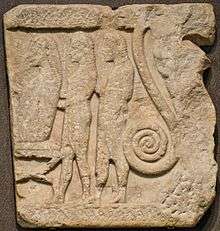Epeius of Phocis
In Greek mythology, Epeius (/ɪˈpaɪ.əs/; Ancient Greek: Ἐπειός) or Epeus, a Greek soldier during the Trojan War or in some accounts, even one of the Achaean Leaders during the said war leading a contingent of 30 ships from the islands of the Cyclades.[1] He was also the architect who constructed the Wooden Horse with the help of which the Achaeans could take Troy; he was himself among those warriors who hid inside it.[2][3][4]

Mythology
Epeius had the reputation for being a coward but in the Iliad he was victorious after participating in the boxing match against Euryalus at the funeral games in honour of Patroclus. Later during the funeral games for Achilles he fought Acamas the son of Theseus to a stalemate. He built the Trojan Horse, commissioned by Odysseus because Athena had told him in a dream she would be with him to help build it. The horse was hollow and was large enough to hold 30 Greek soldiers equipped with all their armor but Epeius made the Trojan horse so tall that it could not fit through any of the gates of Troy. The trap door of the horse was fastened with a special catch that only Epeius could undo. After constructing the massive horse, he chose the other 29 soldiers that would accompany him inside the horse. He also founded Pisa and Metapontum.[5]
Notes
| Wikimedia Commons has media related to Epeius. |
- Dictys Cretensis, Trojan War Chronicle 1.17
- Pseudo-Apollodorus, Epitome 5.14
- Tzetzes, Posthomerica 641–650
- Quintus Smyrnaeus, The Fall of Troy xii.314-335
- Virgil, Aeneid 2.264.